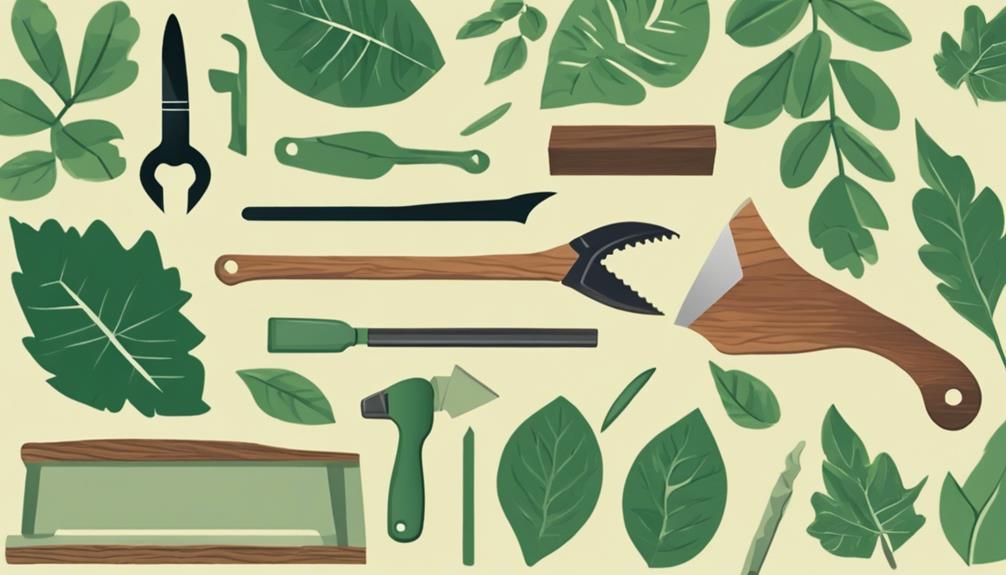While traditional woodworking relies heavily on seasoned timber and energy-intensive tools, green woodworking offers an alternative that’s both ancient and pioneering.
You’re stepping into a realm where the essence of crafting with hand tools like hatchets and drawknives not only connects you to the material in a more intimate way but also significantly reduces your carbon footprint.
By embracing these practices, you’re not just making beautiful pieces; you’re also contributing to a more sustainable world.
Let’s explore further why adopting these tools and methods could be a game-changer for your craft and the environment.
Contents
Essential Hand Tools

In green woodworking, you’ll find that essential hand tools like hatchets, froes, and drawknives not only minimize your ecological footprint but also offer innovative and practical solutions for crafting wood. Using an axe for felling trees and a froe paired with a maul for splitting logs showcases how these tools work harmoniously with nature.
The drawknife and spokeshave excel in shaping and smoothing, allowing for precise control over your work. When it comes to joining pieces, braces, and auger bits create clean, round holes without the need for electricity. Wedges, too, play a crucial role in opening up stubborn wood pieces, making every step of green woodworking efficient and sustainable.
These hand tools embody the essence of working closely with wood, respecting its integrity while crafting.
Energy-Efficient Power Tools
Shifting to energy-efficient power tools marks a significant step toward reducing your workshop’s carbon footprint while maintaining high productivity. These innovative tools not only consume less electricity, leading to lower energy consumption but they’re also equipped with advanced technologies like brushless motors. This means they’re not just green; they’re designed for efficiency and longevity.
As manufacturers increasingly focus on developing tools with eco-friendly features, you’ll find that choosing these energy-efficient options doesn’t just minimize environmental impact; it also leads to significant savings on your electricity bills. By integrating these tools into your woodworking practices, you’re not only making a smart choice for your wallet but also contributing to a more sustainable planet.
Sustainable Wood Sources

Choosing sustainable wood sources is crucial for minimizing your project’s environmental footprint and supporting eco-friendly woodworking practices. When you’re carving out your next spoon or shaping a rough piece of wood on your shaving horse, consider where your material comes from. Using sustainable wood not only aligns with green woodworking tools but also enhances the eco-conscious spirit of your craft.
- Responsibly managed forests ensure biodiversity and ecosystem health.
- Reclaimed wood from old buildings, barns, or pallets provides a second life to materials.
- Urban lumber from trees removed due to disease or development reduces waste.
- Salvaged wood from fallen trees or pruning promotes sustainability.
Each choice reflects a commitment to eco-friendly practices, making every used tool, from knives to hook tools, part of a greener woodworking journey.
Eco-Friendly Finishes
You’ll find that applying eco-friendly finishes is a crucial step in preserving both your wood projects and the planet.
Whether you’re using carving knives for intricate designs, an axe or hatchet for rough cuts, or a wooden mallet and spoon knife for spoon carving, choosing finishes like linseed oil, tung oil, or walnut oil enhances the sustainability of your work.
These natural oils, along with beeswax and carnauba wax, provide a protective layer that’s kind to both curved surfaces and chair seats.
For those delicate shave horse projects or when highlighting the unique patterns made by hook knives, shellac offers a non-toxic, renewable option.
For vibrant, eco-conscious color, milk paint and water-based polyurethane finishes are low-VOC choices that ensure your woodworking remains green at every stage.
Recycling Wood Waste

After exploring eco-friendly finishes, it’s crucial to consider how recycling wood waste can further reduce your project’s environmental footprint. As a green woodworker, you’re not just making rustic furniture or detailed carvings; you’re part of a movement that values sustainability.
Here’s how you can make a difference:
- Repurpose scrap wood for smaller projects or kindling, minimizing the need for new materials.
- Use sawdust and wood shavings for composting or as natural mulch, turning waste into a resource.
- Employ wood chips for landscaping, animal bedding, or even smoking meats, showcasing their versatility.
- Salvage reclaimed wood from old structures for new projects, embodying the essence of green woodworking.
Tools for green woodworking, like carving hatchets, knives, and tools designed for splitting logs or making chair spindles, become even more valuable when you’re working with wood in an eco-conscious manner.
Conclusion
In embracing green woodworking, you’re not just crafting with your hands; you’re nurturing the planet.
By choosing hand tools that resonate with tradition, opting for power tools that sip energy, sourcing wood sustainably, and applying eco-friendly finishes, you’re part of a vital shift.
Don’t forget the magic of recycling wood waste; it’s innovation at its finest.
This journey isn’t just about making; it’s about making a difference.
Here’s to creating with care, for both craft and Earth.






